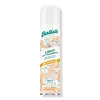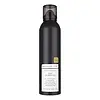What's inside
What's inside
 Key Ingredients
Key Ingredients

No key ingredients
 Benefits
Benefits

 Concerns
Concerns

 Ingredients Side-by-side
Ingredients Side-by-side

Isobutane
Hydrofluorocarbon 152a
Dimethylimidazolidinone Rice Starch
AbsorbentAlcohol Denat.
AntimicrobialButane
Parfum
MaskingAluminum Starch Octenylsuccinate
AbsorbentWater
Skin ConditioningAcrylates Copolymer
Magnesium Carbonate
AbsorbentEthylhexyl Methoxycinnamate
UV AbsorberVp/Va Copolymer
Cetearamidoethyldiethonium Succinoyl Hydrolyzed Pea Protein
CleansingHypnea Musciformis Extract
Skin ProtectingGlycerin
HumectantSargassum Filipendula Extract
Skin ProtectingPanthenol
Skin ConditioningTetrahexyldecyl Ascorbate
AntioxidantSorbitol
HumectantCaprylic/Capric Triglyceride
MaskingAmp-Isostearoyl Hydrolyzed Wheat Protein
CleansingChamomilla Recutita Flower Extract
MaskingHelianthus Annuus Seed Oil
EmollientMangifera Indica Seed Butter
Skin ConditioningPersea Gratissima Oil
Skin ConditioningRicinus Communis Seed Oil
MaskingPentylene Glycol
Skin ConditioningCoco-Glucoside
CleansingGelidiella Acerosa Extract
Skin ProtectingT-Butyl Alcohol
PerfumingPhenoxyethanol
PreservativeAlgin
MaskingBHT
AntioxidantCarrageenan
Chitosan
Guar Hydroxypropyltrimonium Chloride
Skin ConditioningSorbitan Oleate
EmulsifyingXanthan Gum
EmulsifyingRhodiola Rosea Root Extract
EmollientEthylhexylglycerin
Skin ConditioningDenatonium Benzoate
MaskingIsobutane, Hydrofluorocarbon 152a, Dimethylimidazolidinone Rice Starch, Alcohol Denat., Butane, Parfum, Aluminum Starch Octenylsuccinate, Water, Acrylates Copolymer, Magnesium Carbonate, Ethylhexyl Methoxycinnamate, Vp/Va Copolymer, Cetearamidoethyldiethonium Succinoyl Hydrolyzed Pea Protein, Hypnea Musciformis Extract, Glycerin, Sargassum Filipendula Extract, Panthenol, Tetrahexyldecyl Ascorbate, Sorbitol, Caprylic/Capric Triglyceride, Amp-Isostearoyl Hydrolyzed Wheat Protein, Chamomilla Recutita Flower Extract, Helianthus Annuus Seed Oil, Mangifera Indica Seed Butter, Persea Gratissima Oil, Ricinus Communis Seed Oil, Pentylene Glycol, Coco-Glucoside, Gelidiella Acerosa Extract, T-Butyl Alcohol, Phenoxyethanol, Algin, BHT, Carrageenan, Chitosan, Guar Hydroxypropyltrimonium Chloride, Sorbitan Oleate, Xanthan Gum, Rhodiola Rosea Root Extract, Ethylhexylglycerin, Denatonium Benzoate
Ingredients Explained
These ingredients are found in both products.
Ingredients higher up in an ingredient list are typically present in a larger amount.
Alcohol Denat. is an alcohol with a denaturant property. It is created by mixing ethanol with other additives.
This ingredient gets a bad rep because it is irritating and drying - mostly due to its astringent property. Astringents draw out natural oils in tissue, constricting pores and leaving your skin dried out.
However, alcohol denat. is not all that bad.
Due to its low molecular weight, alcohol denat. tends to evaporate quickly. One study on pig skin found half of applied alcohol evaporated in 10 seconds and less than 3% stayed on skin.
This also helps other ingredients become better absorbed upon application.
Studies are conflicted about whether this ingredient causes skin dehydration. One study from 2005 found adding emollients to propanol-based sanitizer decreased skin dryness and irritation. Another study found irritation only occurs if your skin is already damaged.
Small amounts of alcohol are generally tolerated by oily skin or people who live in humid environments.
The rule of thumb is if this alcohol is near the end of an ingredients list, it will probably not affect your skin much.
Also...
This ingredient has antimicrobial and solvent properties.
The antimicrobial property helps preserve products and increase their shelf life. As a solvent, it helps dissolve other ingredients.
Other types of astringent alcohols include:
Learn more about Alcohol Denat.Butane is a gas derived from petroleum and natural gas. It is used as an aerosol propellant.
We don't have a description for Hydrofluorocarbon 152a yet.
Parfum is a catch-all term for an ingredient or more that is used to give a scent to products.
Also called "fragrance", this ingredient can be a blend of hundreds of chemicals or plant oils. This means every product with "fragrance" or "parfum" in the ingredients list is a different mixture.
For instance, Habanolide is a proprietary trade name for a specific aroma chemical. When used as a fragrance ingredient in cosmetics, most aroma chemicals fall under the broad labeling category of “FRAGRANCE” or “PARFUM” according to EU and US regulations.
The term 'parfum' or 'fragrance' is not regulated in many countries. In many cases, it is up to the brand to define this term.
For instance, many brands choose to label themselves as "fragrance-free" because they are not using synthetic fragrances. However, their products may still contain ingredients such as essential oils that are considered a fragrance by INCI standards.
One example is Calendula flower extract. Calendula is an essential oil that still imparts a scent or 'fragrance'.
Depending on the blend, the ingredients in the mixture can cause allergies and sensitivities on the skin. Some ingredients that are known EU allergens include linalool and citronellol.
Parfum can also be used to mask or cover an unpleasant scent.
The bottom line is: not all fragrances/parfum/ingredients are created equally. If you are worried about fragrances, we recommend taking a closer look at an ingredient. And of course, we always recommend speaking with a professional.
Learn more about Parfum